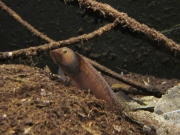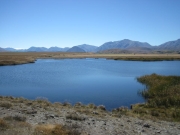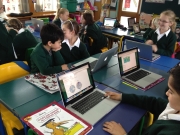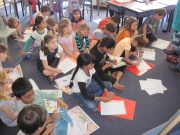<- Homepage: Bioblitz: What's in your backyard?
All LEARNZ field trips targeting primary and secondary schools are closely linked to the New Zealand curriculum, in particular science, social studies and geography. They can also be used by other subject teachers.
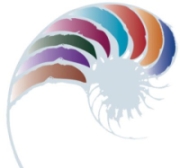
Also see Resources.
Key concepts
Animals, bioblitz, biodiversity, biological communities, birds, citizen science, citizenship, community involvement, conservation, data, ecology, ecosystems, environment, environmental action, guardianship, habitat, kaitiaki, kaitiakitanga, monitoring change, native birds, native plants, native species, pests, planting, plants, restoration, science, sustainability, threatened species, wetlands.
The New Zealand Curriculum - NZC
Key Competencies
LEARNZ virtual field trips contribute to the development of all five key competencies:
| Key competencies | Examples of related field trip components |
| Thinking | Constructing questions to put to experts during Web conferences. |
| Using language, symbols and texts | Interpreting and making meaning of a variety of language and symbols in the Background Pages and throughout the web site. |
| Managing self | Numerous content-related Activities provide students with chances to engage with the material and create their own interpretation of the content. |
| Relating to others | Videos connect students with a range of expert opinions. Students listen actively when seeking answers to video questions. |
| Participating and contributing | LEARNZ Virtual Field Trips are an ideal medium for group-based topic inquiry. They also enable students to transfer new learning into the context of their own communities where they are encouraged to take action. |
(See page 12-13 NZC 2007)
Values
The BioBlitz field trip encourages, models and explores these values:
- innovation, inquiry and curiosity
- ecological sustainability
- community and participation
(see page 10 NZC 2007).
E-learning and pedagogy
The BioBlitz field trip directly involves learning that is supported by information and communication technology (ICT).
In particular, the trip will:
- Assist the making of connections by enabling students to enter and explore new learning environments, overcoming barriers of distance and time.
- Facilitate shared learning by enabling students to join or create communities of learners that extend well beyond the classroom.
- Enhance opportunities to learn by offering students virtual experiences and tools that save them time, allowing them to take their learning further (Page 36 NZC 2007).
Science
| Strand | Achievement Aims |
|
Nature of Science |
Participating and contributing
Explore various aspects of an issue and make decisions about possible actions. Communicating in science
|
|
Living World |
Life Processes
Ecology
|
|
Planet Earth and Beyond |
Earth systems
|
Social Science
| Strand | Achievement Aims |
|
Identity, Culture and Organisation
Continuity and Change
Place and Environment
|
Level 1: Understand how places in New Zealand are significant for individuals and groups.
Level 2: Understand how places influence people and people influence places.
Level 3: Understand how groups make and implement rules | Understand how people view and use places differently.
Level 4: Understand that events have causes and effects. |
English
The selected processes and strategies indicators used in the table below are from Level three of the NZC, but aim to cover indicators from levels two to four.
| Strand | Processes and strategies indicators | Example of related field trip component |
|
Speaking, Writing and Presenting |
|
|
|
Listening, Reading and Viewing |
|
|


